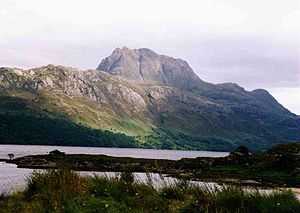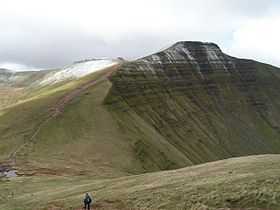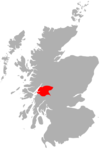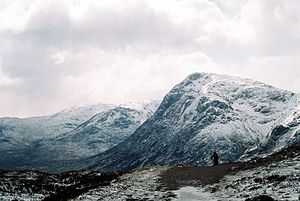Bidean nam Bian
| Bidean nam Bian | |
|---|---|
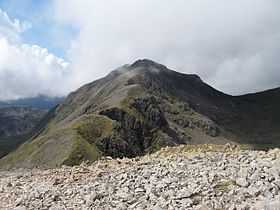 Bidean nam Bian seen from Stob Coire Sgreamhach | |
| Elevation | 1,150 m (3,770 ft)[1] |
| Prominence | 845 m (2,772 ft)Ranked 22nd in British Isles |
| Parent peak | Ben Nevis |
| Listing | Munro, Marilyn, County top (Argyll) |
| Translation | Fence of the hides[2] or Peak of the Mountains[3] (Gaelic) |
| Pronunciation |
Scottish Gaelic: [ˈpitʲan nəm ˈpian] English approx: bit-yan nuhm beahn |
| Location | |
| Location | Glen Coe, Scotland |
| OS grid | NN143542 |
| Topo map | OS Landranger 41 |
Bidean nam Bian, lying to the south of Glen Coe, Highland, Scotland, is the highest point in the former county of Argyll. It is a complex mountain, with many ridges and subsidiary peaks, one of which, Stob Coire Sgreamhach, is classified as a separate Munro.
The most noticeable features of Bidean nam Bian are the famous Three Sisters of Glen Coe, three steeply-sided ridges that extend north into the Glen. Two of the sisters, Gearr Aonach (Short Ridge) and Aonach Dubh (Black Ridge) converge at Stob Coire nan Lochan, a 1,115 m (3,658 feet) subsidiary peak of Bidean nam Bian that lies about 1 km to the northeast of the actual summit. The final, most easterly sister, Beinn Fhada (Long Hill), joins the Bidean nam Bian massif at the summit of Stob Coire Sgreamhach.
Beinn Fhada is separated from Gearr Aonach by a glen known as Coire Gabhail. This translates to Glen of Capture, however the glen is more normally known as the Hidden or Lost Valley. Either name may be considered appropriate since it is believed that in former times the valley was used by members of Clan Macdonald to hide stolen Clan Campbell cattle. The glen is ideal for this purpose since it is blocked by a glacial landslip, and from Glen Coe appears as a narrow gorge. In fact, once past the landslip the floor of the glen is wide and flat – ideal for cattle. The path from Glen Coe through the gorge into Coire Gabhail is a popular short walk (around 4 km in total), though it is rough in places.
| Listed summits of Bidean nam Bian | ||||
| Name | Grid ref | Height | Status | |
|---|---|---|---|---|
| Bidean nam Bian | NN143542 | 1150 m (3773 ft) | Munro, Marilyn | |
| Stob Coire nan Lochan | NN148548 | 1115 m (3658 ft) | Munro top | |
| Stob Coire nam Beith | NN139545 | 1107 m (3632 ft) | Munro top | |
| Stob Coire Sgreamhach | NN154536 | 1072 m (3517 ft) | Munro | |
Ascent routes
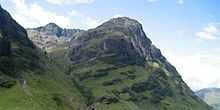
There are several routes up onto Bidean nam Bian. One may continue from the hidden valley, reaching the main ridge by means of a zig-zag path that climbs through scree at the head of the corrie. From here one may also climb Stob Coire Sgreamhach which lies only about 0.5 km to the southeast.[4]
Other routes include ascending Stob Coire nan Lochan and then using the connecting ridge to reach the main summit, or ascending via the Allt Coire nam Beitheach and following either branch of this burn to reach the main ridge either side of the subsidiary peak of Stob Coire nam Beith, which lies about a kilometre to the west of the main summit.[4]
All of the above routes start from Glen Coe and go through the corries running between the Three Sisters, and may thus be combined to allow a traverse of the mountain. Due to the accessibility of Bidean from the north, routes on the southern side are used much less frequently.
Avalanche
On 19 January 2013 four people were killed in an avalanche close to Church Door Buttress on the north side of Bidean nam Bian.[5] A fifth person was airlifted to hospital with serious injuries and a sixth escaped unharmed. It was the worst avalanche in Scottish history and the worst in the UK since the Lewes avalanche in 1836.
External links
References
- ↑ "www.munromagic.com Bidean nam Bian". MunroMagic.com. Retrieved 22 November 2013.
- ↑ McBain's Etymological Dictionary of the Gaelic Language
- ↑ Peter Hodgkiss, The Central Highlands, Scottish Mountaineering Club District Guidebook, 5th ed. (Scottish Mountaineering Trust, 1994)
- ↑ 4.0 4.1 "Glencoe". The National Trust for Scotland. Retrieved July 13, 2012.
- ↑ "Glencoe avalanche: Four dead, say police". BBC News (BBC). 19 January 2012. Retrieved 20 January 2012.
| ||||||||||||||||||||||||||||
| ||||||||||||||||
